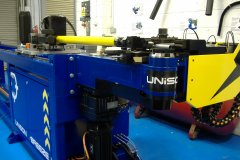Oct 14 2009
Unison has supplied a second all-electric tube bending machine to Boeing Integrated Defense Systems. The order for the machine came just two years after Unison delivered the first system.
 Photo shows the Unison Breeze 20 tube bending machine, prior to shipment to Boeing Integrated Defense Systems.
Photo shows the Unison Breeze 20 tube bending machine, prior to shipment to Boeing Integrated Defense Systems.
The Unison tube bending machine - a Breeze 20 system capable of making precision bends on high performance alloy and aluminum tubes with diameters of up to 3/4 inch (20 mm) - was built at Unison's facility in Scarborough, UK, and shipped in mid July. It was installed at Boeing Integrated Defense Systems' rotorcraft manufacturing facility in Ridley Park on the outskirts of Philadelphia, to be used to fabricate hydraulic and fuel line components for CH/MH-47 Chinook helicopters, as well as for the V-22 Osprey tiltrotor aircraft. The bending machine features a 'long nose', which allows it to shape tubes with complex bends, and very short distances between bends, in a single fully-automated operation.
Boeing's Chinooks are medium-to-heavy-lift helicopters, designed for intra-theater troop and cargo movement. They are used in a wide variety of operational roles, from combat to disaster relief, and are in service with the armed forces of nearly 20 countries worldwide. The latest model - the CH-47F - is designed to extend the service life of the Chinook class beyond 2030. Its airframe uses larger single-piece sections than previous models, to reduce vibration and the need for fasteners, and to help reduce maintenance costs.
The first production model of the CH-47F was rolled out from Ridley Park on June 15, 2006. The US Army has since taken delivery of 77 of these helicopters, and in August last year awarded Boeing a multi year contract for 191, with options on another 24. The Netherlands, Italy and Canada have also placed orders for CH-47F Chinooks.
Unison's Breeze 20 tube bending machine uses servo motors instead of hydraulic force to control the tube bending process. All-electric actuation provides significant advantages related to manufacturing precision, repeatability and energy consumption. Each of the tools employed during bending is under software control, allowing operators to create smooth bends with optimal flow performance and strength. Once the machine is set up, operating parameters can also be stored, allowing machines to be reconfigured for another part or batch in a few minutes, without creating any scrap. Further, as the actuation elements of the machine only need energy when a bend is being made, total power consumption is greatly reduced.